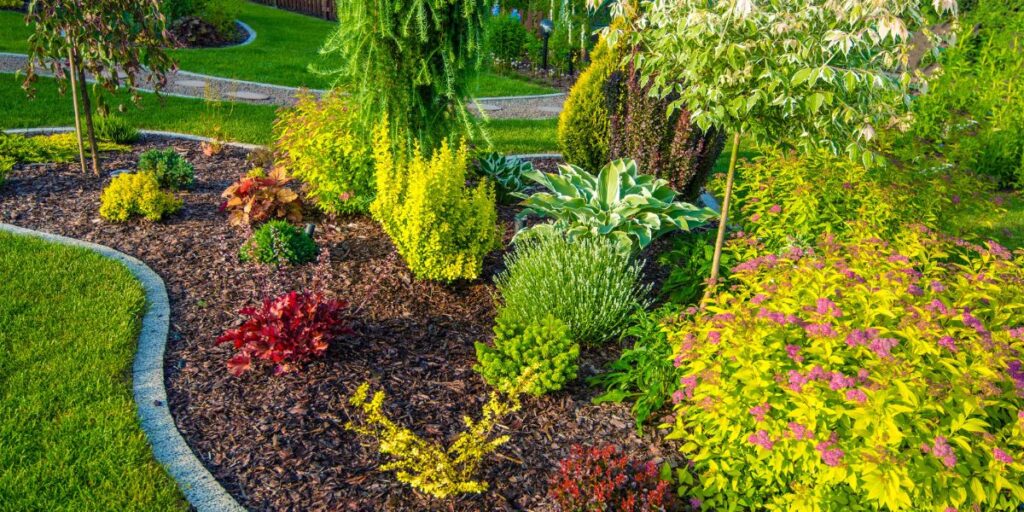
Incorporating drainage solutions doesn’t mean sacrificing the beauty of your landscape. Due to our rainfall, incorporating drainage is necessary to preserve the health of your plants, protect your home, and prevent erosion. Well-designed drainage solutions should become an integral part of your landscape.
Preserving Plant Health
Proper drainage is paramount to the health of your plants. Stagnant water around the roots can lead to root rot and other water-related diseases, compromising the vitality of your greenery. By incorporating drainage solutions such as French drains or gravel-filled trenches, you allow excess water to escape, preventing waterlogged soil and safeguarding the well-being of your plants.
Erosion Prevention
One of the most significant threats to a well-manicured landscape is erosion. Sloping terrain and heavy rainfall can lead to soil erosion, washing away valuable topsoil and leaving behind barren patches. Integrating solutions like retaining walls and strategically placed rocks helps control water runoff, prevent erosion, and maintain the structural integrity of your landscape.
Hardscape Protection
Proper drainage isn’t only about safeguarding your plants; it’s also about protecting your hardscape elements. Paved surfaces, such as driveways and patios, can suffer damage from standing water or excessive runoff. Installing permeable pavers or creating designated drainage channels ensures that water is directed away from these surfaces, preventing cracks, uneven settling, and other forms of deterioration.
Basement and Foundation Preservation
Improper drainage can have severe consequences for the foundation of your home. Excess water pooling around the foundation can lead to cracks, leaks, and structural damage. Implementing solutions like downspout extensions and grading adjustments directs water away from the foundation, preserving the integrity of your home and preventing costly repairs.
Options for Landscape Drainage
French Drain
A French drain is a perforated pipe enveloped in gravel. It quietly redirects excess water, protecting your landscape without compromising its visual appeal. From preventing waterlogged soil around plants to mitigating flooding, the French drain is often used in Pacific Northwest landscapes.
Channel Drain
These sleek linear drains, typically positioned in paved areas, efficiently collect and redirect surface water, preventing puddling and potential damage to hardscape elements. These are often used in driveways, patios, or walkways. Channel drains can be a good solution to surface water management in your
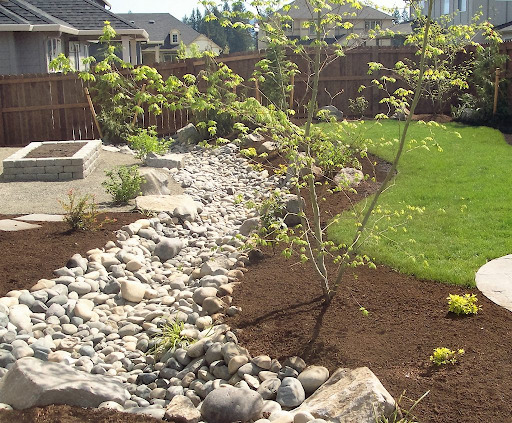
Incorporate Dry Creek Beds
A dry creek bed is an attractive bed of rocks that simulate a creek or river running through your yard. It can be used as a focal point and aids in landscape drainage.
Rain Gardens
Rain gardens offer several environmental and practical benefits, making them a valuable landscape drainage solution and staying sustainable. Rain gardens capture and absorb rainwater, reducing the amount of stormwater runoff that would otherwise flow into storm drains and potentially overwhelm local sewer systems. By slowing down and retaining rainwater, rain gardens help prevent flooding in low-lying areas during heavy rainfall events.
Add Gravel and Mulch

Mulch and gravel can both play important roles in improving drainage in your yard, but they serve slightly different purposes. Here’s how each can contribute to better drainage.
Mulch:
Water Retention:
Mulch, especially organic mulches like wood chips or bark, helps retain moisture in the soil. While it retains water at the surface, it also allows water to percolate into the soil slowly.
Soil Structure Improvement:
As organic mulch breaks down over time, it contributes organic matter to the soil, enhancing its structure. Improved soil structure promotes better drainage by preventing compaction and allowing water to move more freely.
Erosion Control:
Mulch provides a protective layer that helps prevent soil erosion caused by heavy rain or water runoff. This protection is crucial for maintaining the integrity of the soil and preventing the loss of topsoil.
Temperature Regulation:
Mulch acts as an insulator, helping to regulate soil temperature. This can be beneficial for plant roots, and it also contributes to the overall health of the soil ecosystem.
Gravel:
Surface Drainage:
Gravel is often used as a surface material in areas where water runoff is a concern. It allows water to flow easily over its surface, reducing the risk of soil erosion and preventing puddles.
Permeability:
Gravel is highly permeable, allowing water to pass through it easily. This is useful for areas where you want to drain and prevent water from pooling.
Visual Appeal:
Gravel can be a visually appealing addition to landscaping. It’s available in various colors and sizes, allowing the creation of different pathways or decorative features while still helping the drainage in your yard.
Add Plants that Tolerate Wet Soil

Plants can absorb excess water and improve soil and drainage in your yard. You may want to consider plants that can tolerate wet soils.
Plants for Soggy Sites:
Trees:
- Bald cypress
- Tupelo
- Water birch
- Cascara
- Red osier dogwood
- Willows
Shrubs:
- Buttonbush
- Purple osier willow
- Winterberry
Perennials:
- Blue flag
- Cardinal flower
- Japanese iris
- Japanese primrose
- Umbrella plant
- Water iris
- Maidenhair Fern
Grass and rush-like plants:
- Japanese sweet flag
- Rush
- Sedge (Carex elata ‘Aurea’)
- Sweet flag (Acorus calamus)
Integrating drainage solutions into your landscape is a proactive and essential step toward maintaining a healthy, vibrant outdoor space. Our team can design and install landscape drainage solutions that are functional and attractive. Give us a call today!
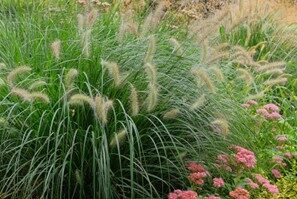
 Adding texture to your garden is a great way to make it stand out and look unique. By incorporating plants with various textures, you can create an eye-catching display.
Adding texture to your garden is a great way to make it stand out and look unique. By incorporating plants with various textures, you can create an eye-catching display.
From grasses to shrubs and succulents, many plants are spiny, peeling, or feathered in texture that can be added to your landscape.
Perennials for Texture
Perennials are a great way to add texture to your landscape. They come back year after year and can give your garden a unique and beautiful look. Perennials come in all shapes, sizes, and colors and can be used to create any garden design.
Consider plants such as:
- Sedum
- Elephant Ears (Bergenia)
- Sword Fern
- Wild Ginger
- Allium
- Astilbe
- Santolina Chamaecyparissus
- Lamb’s Ear
- Yucca
- Sea Holly
Ornamental Grasses for Texture
Adding ornamental grasses to your landscape is an easy way to add both texture and movement to your yard.
For those looking for year-round interest, ornamental grasses offer great value as many varieties can remain standing throughout the winter months. Their airy habit can soften a landscape and act as a backdrop for other plants in the garden.
When selecting ornamental grasses, consider the size of the mature plants and the amount of sunlight they will receive. Some varieties can reach heights of 4-6 feet and require full sun, while others stay relatively low in height and prefer partial shade.
- Deschampsia
- Carex
- Orange Sedge
- Northern Sea Oats
- Black mondo grass
No matter which type of ornamental grass you choose, cutting back the foliage at least once a year is important to keep the grass healthy and encourage new growth. This task is best done in late winter or early spring before new growth begins.
Shrubs for texture
Shrubs are a great way to add texture and depth to your landscape. Whether you’re looking for evergreen shrubs, flowering shrubs, or low-maintenance varieties, many options give your garden year-round texture and interest.
Popular shrubs to include:
- Red twig dogwoods
- Japanese holly
- Evergreen huckleberry
- Oakleaf hydrangea
- Smokebush
No matter what type of shrub you choose, be sure to research it thoroughly before planting. Each type of shrub has different requirements for light, water, and soil, so you want to make sure you pick one that will thrive in your garden.
 Textural Trees
Textural Trees
Trees are a great way to add texture to your landscape. They can provide privacy and protection from harsh winds and intense sunlight.
Try the following trees:
- Raywood’s Weeping Arizona cypress
- Pacific Madrone
- River Birch
- Hinoki false cypresses
- Thunderhead Japanese Black Pine
When selecting trees for your landscape, consider the mature size of the tree, as well as its growth rate. Think about where you plan to plant the tree, such as an area with direct sunlight or a more sheltered location with dappled light.
Need help with your landscape design or pairing plants with your hardscapes? Call us for a free consultation at (360) 574-8979.
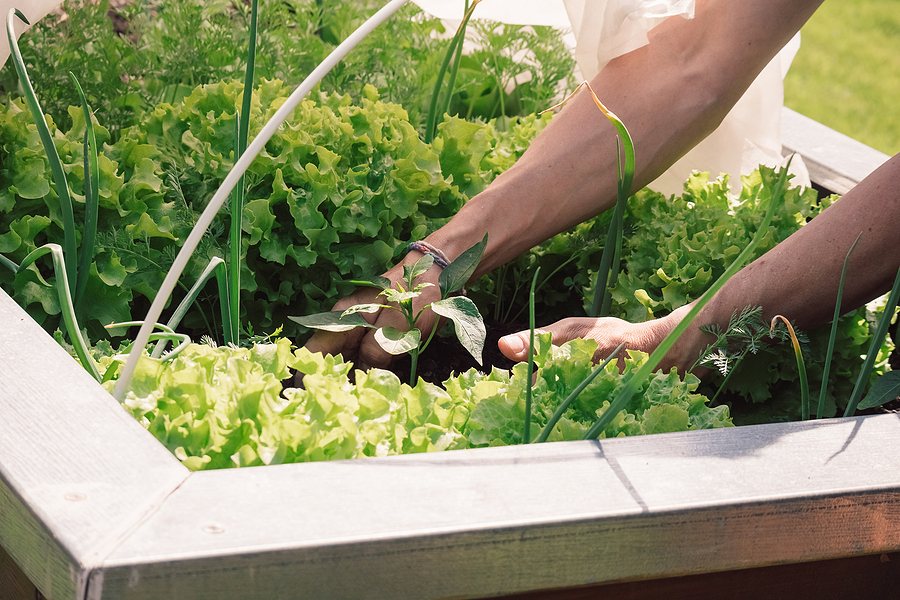 Raised beds have become increasingly popular among gardeners and for a good reason. They are an attractive addition to any outdoor space and provide numerous practical benefits that make gardening more accessible and rewarding. Raised bed gardening may be the perfect solution to elevate your gardening game.
Raised beds have become increasingly popular among gardeners and for a good reason. They are an attractive addition to any outdoor space and provide numerous practical benefits that make gardening more accessible and rewarding. Raised bed gardening may be the perfect solution to elevate your gardening game.
Easy to Maintain
Raised beds are ideal for anyone looking for a low-maintenance garden setup. The soil level allows you to work on your plants without bending down or kneeling on the ground. This makes it easier to pull weeds, add compost, and water your plants. The improved drainage means they don’t need as much attention when watering as ground-level soil. You can also control the soil mix in a raised bed, which makes it easier to maintain your plants’ nutrient needs.
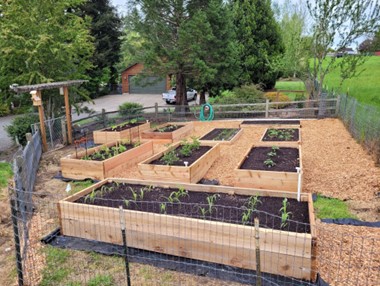 Increase Drainage
Increase Drainage
The higher elevation of the soil helps water flow away from the plant roots, reducing the risk of fungal diseases and root rot that can occur with overly wet soil. This can be especially helpful in landscape areas where water drains slowly or is prone to pooling. Adding gravel or a layer of plastic beneath the soil also helps further improve drainage.
Control Your Soil
Raised beds allow you to control the soil you use for your garden. By building up the sides of the bed, you can fill it with soil from a local garden center or make your own blend. This allows you to tailor the soil to your specific needs and the plants that will be planted in the bed.
A good soil mix is essential for healthy plants and a bountiful harvest. A good soil mix will contain both organic material and inorganic materials to provide necessary nutrients, retain moisture, and aerate the soil. Composted manure, peat moss, or coco coir can be used in raised beds mixed with sand, vermiculite, and perlite. You can create your own custom blend to make a soil blend for your plants.
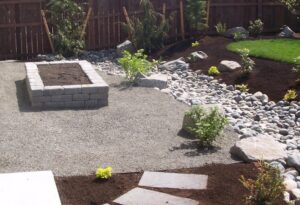
You Can Plant Earlier
Raised beds are typically warmer than traditional gardens because they are off the ground. Extra height and insulation of the soil increase the temperature. This can be beneficial in early spring when the ground can remain cold. With a raised bed, you can start planting earlier in the season.
Make harvesting easier
Raised beds can make harvesting easier because the vegetables are up off the ground and in easy-to-reach locations. It can also eliminate bending over and ensures you’re not pulling up weeds or disturbing the soil. This can save time and energy and help your harvest last longer. Raised beds also provide a convenient platform for trellising, so your vegetables can grow vertically and can be easily harvested.
Frontier Landscaping builds raised beds using a variety of materials. We can also add drip irrigation in the beds and outdoor lighting. Give us a call today for a free estimate at (360) 574-8979.
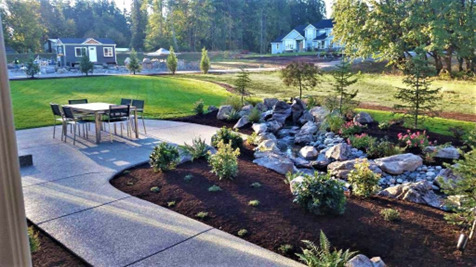
When it’s summer in the Pacific Northwest we want to enjoy the beautiful weather in an outdoor living space. Although outdoor spaces used to just be for patio furniture and a grill they can now include TVs, outdoor kitchens, fire pits, lighting, and more.
Creating an outdoor living space can be a great way to add value to your home and create an area to relax and entertain. Whether you’re starting from scratch or making changes to an existing outdoor area, the time is now to get started on your new landscape.
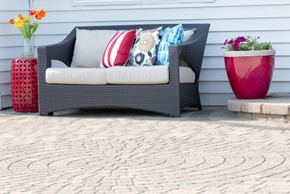 Suited to your own aesthetic tastes, we can create living outdoor living spaces that extend the hospitality of your home, extend and open up an area for entertaining or create a quiet retreat.
Suited to your own aesthetic tastes, we can create living outdoor living spaces that extend the hospitality of your home, extend and open up an area for entertaining or create a quiet retreat.
Planning Your Outdoor Living Space
By planning your new landscape project now we are also able to see how your landscape handles drainage issues so we can see if this needs to be incorporated into your landscape project.
Before you start shopping for furniture and think about hardscapes, take some time to think about how you want to use your outdoor living area. Do you want a place to cook and entertain? A spot to relax with a good book or some music? A place for your kids to play? Consider your needs and lifestyle when deciding how to design your space. With these ideas in mind, you can begin to create a design plan that works best for you and your family.
There are endless design options you can create by choosing natural stone, pavers, bricks, river rocks, and more. Our Professionals at Frontier Landscape can help you design outdoor living spaces that are truly your own.
Outdoor Furniture and Accessories
When you’re planning your outdoor living area, it’s important to choose furniture and accessories that match your style. Think about what kind of atmosphere you want to create with your space. If you’re looking for a cozy and intimate vibe, opt for comfortable seating and inviting fabrics. If you want something more modern and sleek, go for metal furniture and low-maintenance materials.
Adding Hardscaping
When deciding what kind of hardscaping to add, consider the size and shape of your outdoor living area. If you have a small area, then you may want to focus on creating walkways and adding a few steps. If you have a larger area, then you could add a patio or an outdoor kitchen. No matter what type of hardscaping you choose, make sure it fits the overall style of your outdoor living area.
Retaining Walls
If you have a smaller area next to a slope consider installing a retaining wall. Retaining Walls can. They can incorporate straight or curved lines, steps, and corners and serve as added seating. Retaining walls are often used for grade changes, and for other functional reasons such as widening driveways, and walkways, or creating more space in a patio outdoor area. More usable area for your Landscapes and Outdoor Spaces.
Paths and Patios
Paths and Patios can be created using slate, brick, concrete, rough stone, gravel, crushed granite, pavers of all shapes and colors, or a mix therein. We can add a path leading through your property to the patio or any route in between.
Should your outdoor living space need any permits we can get those started for you sooner rather than later. In order to have your outdoor living space ready for summer you need to think now and schedule a free consultation!
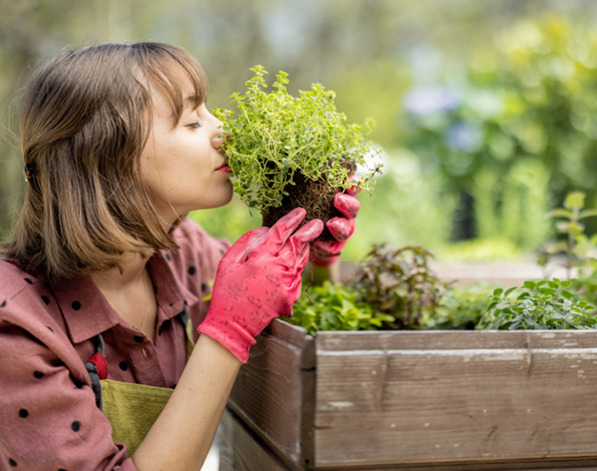
A garden can be a great source of physical activity and mental stimulation. Still, if you have health issues or disabilities, you may need to adjust your garden before digging in the dirt. Read on to learn how to modify your garden, so it’s accessible and enjoyable.
Raised Beds
Raised beds are an excellent way to garden for people who have limited mobility or can’t bend over—these need to be at a comfortable height for seniors and disabled individuals.
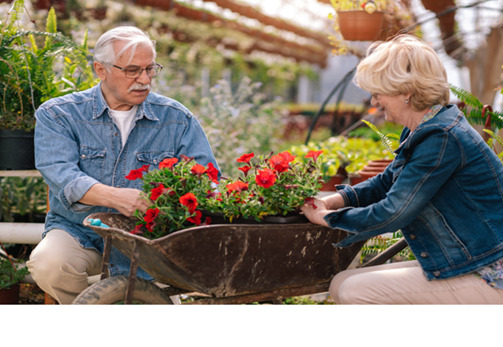
Add potting benches to allow people sitting in wheelchairs to reach over the bed without having to climb onto it. The bed height should be 24 inches for someone seated in a wheelchair and 30 inches for someone who will stand while gardening but has difficulty bending and reaching.
Containers
Gardening in containers is adaptable to indoor and outdoor gardening. Containers can be placed on patios or porches or along walkways. You can also move them so they get enough sunlight.
Vertical Gardening
Climbing plants are fantastic in the garden and can add privacy or disguise a view. They can also provide visual interest year-round, depending on the selected plants. Make sure you are growing the right plants for the right height and can reach them at maturity. For example, consider growing up if you cannot bend down to harvest cucumbers.
A trellis can be placed in a raised bed, container, or the ground. Make sure plant stakes are not sharp and not a tripping hazard.
Some Plants suitable for vertical gardening are:
- Cucumbers
- Tomatoes
- Peas
- Beans
- Squash
- Clematis
- Jasmine
- Rose
Clear and Even Paths
Ensure all paths and walkways are wide enough for someone in a wheelchair. Avoid any slopes or edges that may cause someone to slip or fall. Use a rake to level the soil, especially near the seating area. Be sure that paths have a slight slope so water can run off and prevent slipperiness. Brush hard surfaces with a stiff broom to remove moss.
Adaptive Gardening Tools
Gardening tools come in a variety of sizes for a variety of abilities and situations. If you have difficulty gripping tools, look for larger handled tools or consider adding or modifying existing tools.
These are some of the adaptive gardening tools you might find helpful:
- Kneeling benches or garden scooters can reach plants lower to the ground.
- Arm cuffs go around your forearm and attach to various tools to help extend reach and increase leverage and grip. The tools available for attachment are trowels, forks, and cultivators.
- Telescopic garden tools have an extendable reach, so you can rake or prune by lengthening the handles, even if you are in a wheelchair.
- Grabbers to pick up debris like a giant pair of tongs.
- Hand seed dispensers are simple and plastic for those who have difficulty gripping small objects.
Let us know how we can help make gardening more accessible for you. We create raised beds, seating areas, pathways, and patios depending on your unique needs. Contact us today!
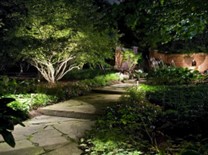 Landscape lighting can add atmosphere and ambiance to your outdoor living space and make it easier to navigate at night. However, where exactly should you install landscape lights? Here are some tips on how to use landscape lighting to create the perfect outdoor oasis and save energy at the same time.
Landscape lighting can add atmosphere and ambiance to your outdoor living space and make it easier to navigate at night. However, where exactly should you install landscape lights? Here are some tips on how to use landscape lighting to create the perfect outdoor oasis and save energy at the same time.
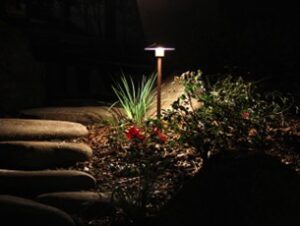 Consider LED lighting
Consider LED lighting
Landscape lighting is a great way to make your outdoor space feel safe, inviting, and romantic.
There are many different types of lighting fixtures that can be used in landscape lighting projects.
The most commonly used type is LED lighting. They have an incredibly long lifespan compared with other lighting options.
Landscape lighting is used to help accentuate your home’s exterior and make it look more attractive. Placing landscape lighting in front of your house can help highlight what you consider to be your home’s most valuable features, like a beautiful garden or a breathtaking view. It can also be used as an additional security measure if you live in a neighborhood that has lots of foot traffic or break-ins.
Lighting Your Patio
If you’re looking for a way to spruce up your patio, consider adding landscape lighting. This will create the perfect space for entertaining during summer evenings, and it’s also an excellent way of ensuring safety in your garden by keeping intruders away at night.
There are many different types of outdoor lights that you can use, so start by deciding what type of lighting you want: spotlights, wall packs, or lights on poles. You may also want to think about how many light fixtures you need and what color bulbs would work best to create the right ambiance.
 Lighting for Driveways, Walkways, and Steps
Lighting for Driveways, Walkways, and Steps
The driveway and walkways are typically the first areas people see when they pull up to a home. The light from these areas can be used to help you create a feel for what is waiting just inside.
Lighting up your steps is a great way to create an inviting pathway and can even be used as a safety feature. If you have children or pets, it will help them see where they are going at night. When picking out bulbs, choose ones that mimic natural daylight so people don’t feel uncomfortable when they are outside after dark.
 Light Up Your Focal Points
Light Up Your Focal Points
If you need more of a focal point for your landscape lighting, consider using lights on trees or shrubs that line your walkways or use accent lights in between the plants in your flowerbeds.
Put up spotlights that focus all their attention on one tree (or any other part of the yard) to create a focal point and a tranquil atmosphere. They provide a focused beam of light on a certain area, but they don’t reach far into the surrounding area.
Floodlights: These lights typically have an oval or circular shape and cast light over a wide range. You may want to use these on a house’s exterior if you want to illuminate it at night, but they can also be used on landscaping features.
There are also lights for your water features that can be beautifully lit at night.
Let the Frontier Landscaping team install your landscape lighting. We’ll help you find the types and styles of lighting that create the atmosphere you want surrounding your home. Installing the right lighting in the right place in your yard can increase its beauty and functionality. Contact us today!







 Adding texture to your garden is a great way to make it stand out and look unique. By incorporating plants with various textures, you can create an eye-catching display.
Adding texture to your garden is a great way to make it stand out and look unique. By incorporating plants with various textures, you can create an eye-catching display. Textural Trees
Textural Trees Raised beds have become increasingly popular among gardeners and for a good reason. They are an attractive addition to any outdoor space and provide numerous practical benefits that
Raised beds have become increasingly popular among gardeners and for a good reason. They are an attractive addition to any outdoor space and provide numerous practical benefits that  Increase Drainage
Increase Drainage

 Suited to your own aesthetic tastes, we can create living outdoor living spaces that extend the hospitality of your home, extend and open up an area for entertaining or create a quiet retreat.
Suited to your own aesthetic tastes, we can create living outdoor living spaces that extend the hospitality of your home, extend and open up an area for entertaining or create a quiet retreat.

 Landscape lighting can add atmosphere and ambiance to your outdoor living space and make it easier to navigate at night. However, where exactly should you install landscape lights? Here are some tips on how to use landscape lighting to create the perfect outdoor oasis and save energy at the same time.
Landscape lighting can add atmosphere and ambiance to your outdoor living space and make it easier to navigate at night. However, where exactly should you install landscape lights? Here are some tips on how to use landscape lighting to create the perfect outdoor oasis and save energy at the same time. Consider LED lighting
Consider LED lighting Lighting for Driveways, Walkways, and Steps
Lighting for Driveways, Walkways, and Steps Light Up Your Focal Points
Light Up Your Focal Points